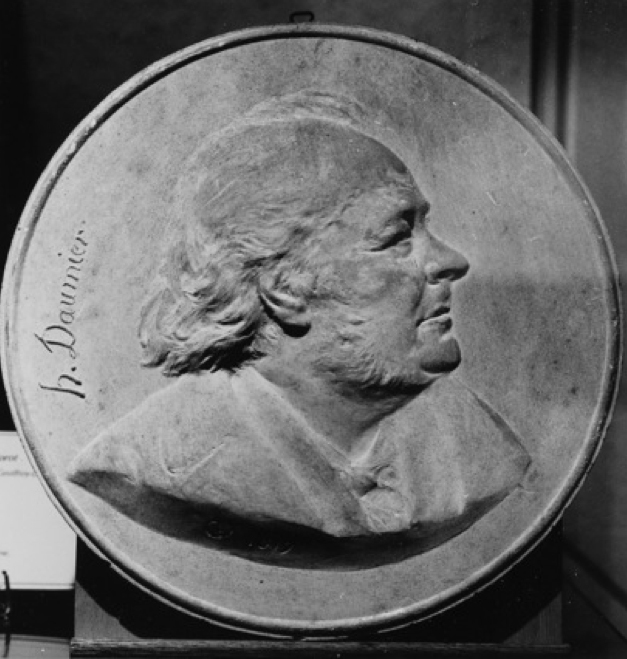ADOLPHE VICTOR GEOFFROY-DECHAUME (Paris 1816 - 1892 Valmondois)
Honoré Daumier
Terracotta
Diameter: 9 3/8 inches (23.9 cm)
Inscribed at left center: h. Daumier
Monogrammed and dated 1879 bottom center
Inscribed reverse: 25 [?] XX5 TN
Attached to reverse: carte de visite of Geoffroy-Dechaume with a dedication
Our terracotta relief of Daumier is signed and dated 1879, as is the plaster (fig. 1) which is in a private collection in France. Geoffroy-Dechaume attached his calling card to the back of our relief and gave it to a friend in remembrance of Daumier. Daumier is sculpted in profile, facing right, his eyes have the glazed look of someone who has lost most of his sight. There is a kindness, however, that is conveyed in the depiction of this great artist. Written into the clay on the back of the relief is a date and other inscriptions that must have been important to Geoffroy-Dechaume. As the calling card obscures most of the writing, they are difficult to decipher.
Fig. 1. Adolphe Victor Geoffroy-Dechaume, Honoré Daumier, patinated plaster medallion, 1879, private collection.
Adolphe Victor Geoffroy-Dechaume was born in Paris in 1816, the illegitimate son of a 17-year-old girl named Elisabeth Aglaé Geoffroy. He was subsequently adopted by Hyacinthe Dechaume, Elisabeth’s husband and, in 1837, officially became Adolphe Victor Geoffroy-Dechaume.
At a young age, Victor exhibited a talent for art and entered a free drawing school, where oddly enough, Eugène Viollet-Le-Duc—the artist with whom Victor would later collaborate on various commissions—was a monitor. In 1831 Victor enrolled at the École des Beaux-Arts, Paris, where he remained a student until 1835. There he studied under Pierre-Jean David d’Angers, James Pradier and Antoine-Louis Barye and became friends with Charles-François Daubigny, Jules Dupré and Auguste Préault.
Victor also excelled in modelling small sculpture and, by 1830, he found work executing models for various Parisian gold and silversmiths. As a result of the Paris Universal Exposition of 1844, the French public became attracted to collecting objets de vertu and, as the demand increased, so did Victor’s work. During the 1840s, Victor developed an interest in serious sculpture. He was subsequently asked to assist his old professors David d’Angers and James Pradier on the sculpture for the Arc de Triomphe and the Church of the Madeleine.
As a result of his collaboration in the 1840s with Viollet-le-Duc on the restoration of Notre Dame de Paris, Sainte-Chapelle, and cathedrals in Amiens, Strasbourg, Dinan and Bayonne, Victor developed an interest in religious architecture. Geoffoy-Dechaume was named a Chevalier de la Légion d’Honneur in 1862 and an Officier de la Légion d’Honneur in 1880.
Geoffroy-Dechaume discovered the village of Valmondois in the Val d’Oise, and purchased a home there, as a result of his lifelong friendship with Charles-François Daubigny (1872 – 1878). The painters Jean-Baptiste Corot and Théodore Rousseau already lived in the village and eventually Daumier also moved to a home in the center of town that Corot had purchased for him. Daumier and Geoffroy-Dechaume became good friends as a result of their mutual love of modelling. Daumier entrusted his friend Geoffroy-Dechaume with his clay models for Ratapoil and The Emigrants, with the intent of eventually casting them in bronze. Both sculptures were considered too politically toxic to be cast until after the end of the reign of Napoleon III. Due to the extreme fragility of the unfired clay, the original models were destroyed during the mold making process.
By the end of his life Daumier was in terrible debt and generally forgotten as an artist. In 1878, his friends—spearheaded by Geoffroy-Dechaume—organized an exhibition of his works at the Galerie Durand-Ruel in Paris. Their hope was to raise money for Daumier and his wife. Unfortunately, the exhibition was neither a critical nor a financial success. Daumier died in February of 1879 at his home in Valmondois. Geoffroy-Dechaume asked Daumier’s widow to save his personal effects with an eye toward sculpting a monument in his honor. Victor designed a tomb monument on which would have been inscribed the titles of Daumier’s major works. The monument was never realized, but Geoffroy-Dechaume did sculpt a portrait medallion for Daumier’s tomb (fig. 1). In 1880, Daumier’s casket was moved to Père Lachaise Cemetery, where it resides today, as Daumier had always wished to be buried alongside his friends Corot and Daubigny. Adolphe Geoffroy-Dechaume, Victor’s son, eventually sculpted a bust of Daumier for a monument which was installed in Valmondois in August 1900 (fig. 2).
Fig. 2. Adolphe Louis Geoffroy-Dechaume, Honoré Daumier, plaster bust, 1889, private collection.



